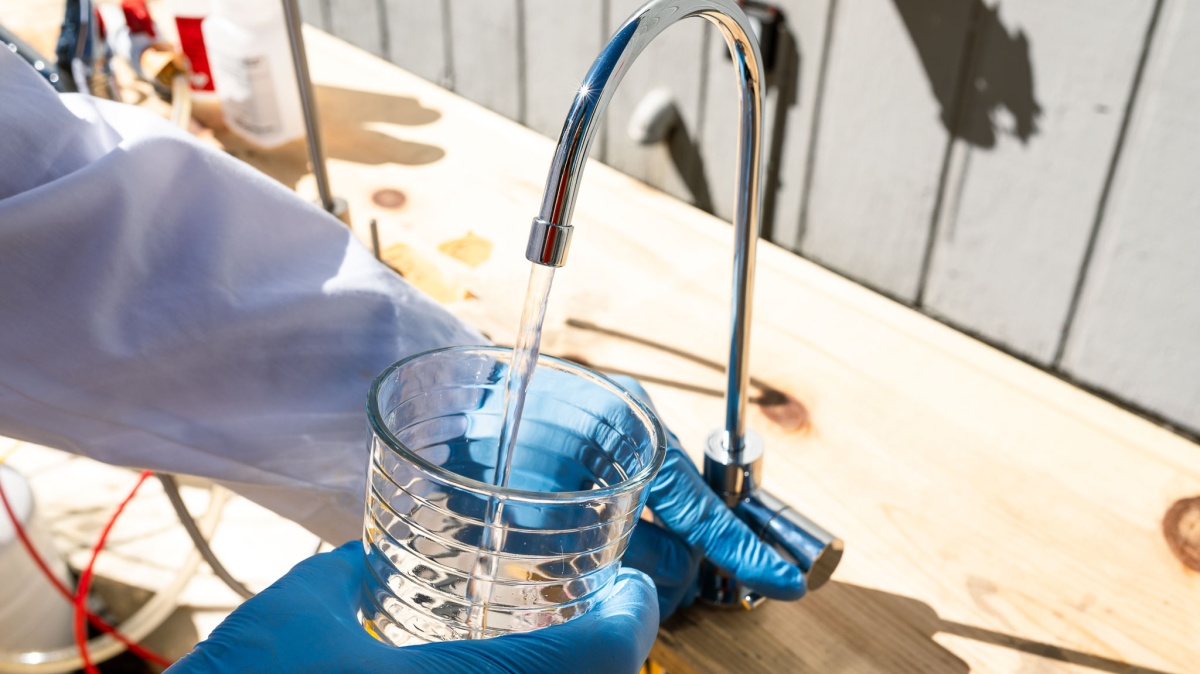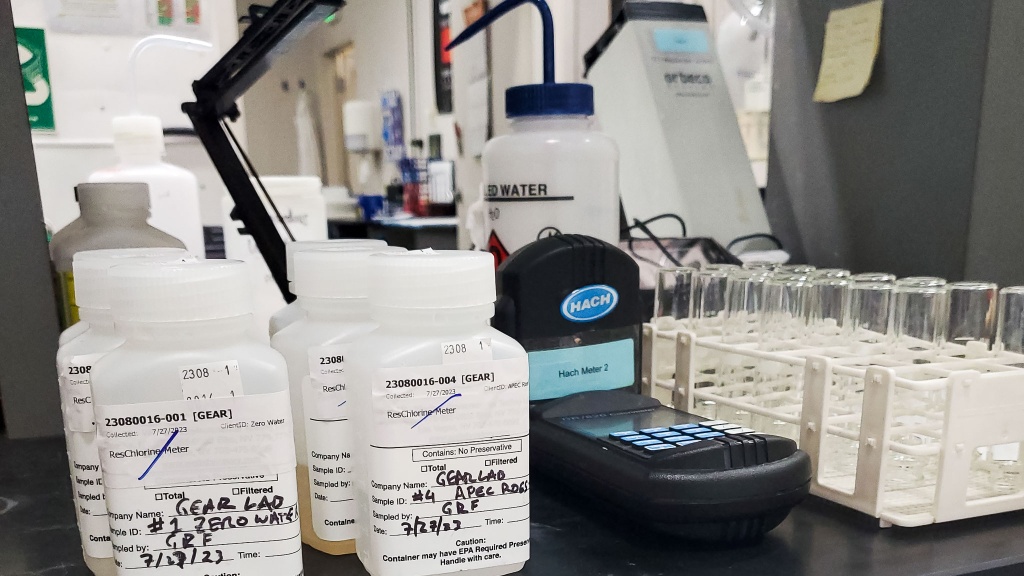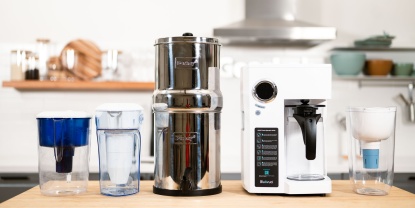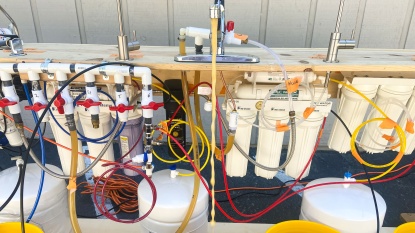Our Verdict
Compare to Similar Products
 This Product APEC WFS-1000 | |||||
|---|---|---|---|---|---|
| Awards | Best Value Under-Sink Filter | Best Value Pitcher Filter | Best Pitcher Water Filter | ||
| Price | $145 List $139.95 at Amazon | $30 List $24.99 at Amazon | $35 List $26.92 at Amazon | $200 List | $42 List $39.99 at Amazon |
Overall Score  |
|||||
| Star Rating | |||||
| Bottom Line | Reduced installation hassle, comparable filtering power, and lowest yearly cost | A low-cost pitcher that easily produces high-quality water | Top-notch filtration and convenience at an affordable price point | A cost-effective reverse osmosis setup that produces highly purified and tasty water | An easy-to-use water pitcher that produces good-tasting water, but struggles to remove certain contaminants |
| Rating Categories | APEC WFS-1000 | PUR Classic 11 Cup... | ZeroWater 10-Cup 5-... | APEC Essence ROES-50 | Brita Tahoe 10-Cup... |
| Contaminant Removal (50%) | |||||
| Taste (30%) | |||||
| Setup and Maintenance (10%) | |||||
| Operating Costs (10%) | |||||
| Specs | APEC WFS-1000 | PUR Classic 11 Cup... | ZeroWater 10-Cup 5-... | APEC Essence ROES-50 | Brita Tahoe 10-Cup... |
| Measured Chlorine Removal | 100% | 95% | 100% | 100% | 75% |
| Measured Fluoride Removal | 100% | 100% | 100% | 95% | 37% |
| PFAS Removal? | Not stated | Not stated | Yes | Yes | Yes |
| Type | 3 Stage under sink | Pitcher | Pitcher | Reverse Osmosis | Pitcher |
| Cost per year (160 gal per month) | $50 | $288 | $450 | $82 | $244 |
| Cost per year (40 gal per month) | $50 | $72 | $58 | $82 | $62 |
| Replacement Schedule | Every 12 months | 40 gallons or 2 months | After 18,000 mg of dissolved solids; 1-40 gallons | Stage 1, 2, 3 Pre-Filters, every 6-12 months Stage 4 RO Membrane, every 2-4 Years Stage 5 Carbon Post-Filter, every 2-4 Years |
After 120 gallons (about every 6 months) |
| Replacement Cost | Stages 1-3 for $50 | $24 for a 4 pack | 2 for $30 4 for $40 8 for $90 12 for $115 16 for $150 |
Stages 1-3 for $27 RO for $45 Carbon for $10 |
$18.40 per filter, $30.49 for two |
| NSF/ANSI certified | NSF Certified filters and tubing | NSF certified to reduce chlorine, mercury, copper, zinc and other chemical & physical substances | N/A | N/A | N/A |
| Measured Sulfate Removal | 39% | 35% | 100% | 100% | 43% |
| Measured Copper Removal | 100% | 88% | 100% | 100% | 17% |
| Measured Iron Removal | 46% | 85% | 99% | 100% | 35% |
| Measured Lead Removal | 100% | 100% | 100% | 100% | 100% |
| Model | WFS-1000 | 11 Cup | 10 Cup | Essence ROES-50 | 10 Cup |
| Waste water generated | 0% | 0% | 0% | 25% | 0% |
| Other certifications | FDA Certified JG Food grade tubing | N/A | IAPMO certified to reduce PFOA/PFOS, lead, chromium and mercury | Water Quality Association (WQA) Certified | IAPMO R&T certified against NSF/ANSI Standard 53 WQA certified against NSF/ANSI Standards 42, 53, and 401 |
Our Analysis and Test Results
The APEC WFS-1000 offers great value to consumers due to its overall taste and simplified setup. This simple yet effective filter was a reliable performer throughout our testing.
Performance Comparison
Contaminant Removal
Household water filters are essential for ensuring our water is safe and free from harmful contaminants. Water filters remove impurities such as chlorine, lead, bacteria, and other pollutants that can cause health problems. Using a water filter can also improve the taste and odor of tap water, making it more appealing to drink. To gauge the effectiveness of each filter, we created and processed a sample of highly contaminated water to run through each filter. Each sample was analyzed by a third-party lab to ensure high-quality data. The APEC WFS-1000 provided effective filtration but struggled to compete with the best in the review.
The APEC WFS-1000 water filter demonstrates a mixed yet effective performance regarding contaminant removal. While it may not be the best choice for filtering water with high levels of sulfates and iron, it shows impressive validity in eliminating certain other contaminants such as chlorine, fluoride, copper, and lead.
The APEC successfully removed 100% of chlorine (12mg/l out of 12mg/l). Cholrine is often added to water supplies as a disinfectant, but it can affect the taste and smell of the water. The filter also eliminated 100% of fluoride (10mg/l out of 10mg/l). While fluoride is beneficial for dental health, excessive amounts can lead to health issues, making its removal important for many households who wind up drinking this element in large quantities.
The APEC erased 100% of copper materials (52 mg/l out of 52 mg/l). High levels of copper in water can cause gastrointestinal distress, and prolonged exposure can lead to liver or kidney damage. The filter successfully eliminated 100% of lead (.02 mg/l out of .02 mg/l). Lead is a toxic metal that can be harmful to human health, even at low exposure levels.
However, the APEC falls short when dealing with sulfates and iron. It only manages to remove 39.13% of sulfate (900 mg/l out of 2300 mg/l). High sulfate levels in water can lead to diarrhea and dehydration, especially in infants. The filter only removes 46.03% of iron (290 mg/l out of 630 mg/l). While iron is an essential nutrient, excessive iron in water can cause a metallic taste and stain fixtures and laundry. These values remained above the standards set by the EPA for acceptable water quality.
Therefore, while it proves generally effective for certain contaminants, it would be best suited for water sources that are not excessively high in iron or sulfates.
Taste
Taste is a crucial factor when considering a water filter because it directly impacts the user's drinking experience. A water filter that can effectively remove contaminants while also improving the taste of the water is highly desirable. We held a blind taste test with a panel of judges to determine the best-tasting water and used filtered water through a garden hose as our sample. The APEC WFS-1000 was a favorite among the test team.
The APEC WFS-1000 provides a neutral and crisp flavor similar to bottled water, which makes drinking water from home a more pleasurable experience. This can be particularly important for households with children, where taste can often be a deciding factor in their willingness to drink water regularly.
Moreover, our panel of testers found the taste of the filtered water enjoyable enough to make it a worthy substitute for bottled water. This not only offers the convenience of having great-tasting water readily available at home, but it also contributes to reducing plastic waste, thus making a positive impact on the environment.
However, it's worth noting that the APEC WFS-1000 may not be as effective when dealing with water sources that have high sulfur content or metallic flavors. These elements can leave a distinct taste in the water, which this model might struggle to completely remove. While it does an excellent job of filtering out common impurities and enhancing the overall taste of tap water, its performance may be less satisfactory when faced with these specific contaminants. Therefore, for those living in areas where the water supply has excess sulfur or metallic flavors, a more versatile filtration system may be required.
Setup and Use
The ease of setting up and using a water filter is another important factor to consider. A water filter that is difficult to install or complicated to use can be a deterrent for many people, potentially leading to improper installation or use, which can affect the filter's performance and lifespan. In our pursuit to assist you in identifying the optimal water filter for your enduring needs, we implement each filter within our uniform test kitchen. We process a substantial amount of water and regularly maintain and compute the wastewater ratios based on our meticulous testing. The APEC WFS 1000 is simpler to install, more affordable, and doesn't produce wastewater compared to a reverse osmosis system.
If you're looking for a water filter that's easy to install and maintain, the APEC WFS-1000 is a great choice. The clear instructions make it simple to set up, and you don't have to worry about installing a tank. Installing the separate faucet is the most intimidating part of the process. The separate faucet has one of the best flow rates within the review.
You'll only need to change the three filters once a year, which are affordably priced. APEC offers additional filters with enhanced performance filtering lead, bacteria, chloramine, and fluoride. The customizable filter set allows you to cater to the composition of the water source.
Operating Costs
When using the standard filter set, this model offers one of the lowest annual costs in our review at $40. Unlike reverse osmosis systems, there's no wastewater to worry about, so you can enjoy clean, great-tasting water without any excess waste or hassle.
Should You Buy the APEC WFS-1000?
If you're in the market for an affordable under-the-sink water filter that doesn't involve the added hassle or wastewater of reverse osmosis systems, then this model is a great choice. The product proved its value throughout our rigorous testing process.
What Other Water Filter Should You Consider?
If you want more filtration ability, then the APEC Essence ROES-50 is an efficient, compact, and simple reverse osmosis system. This model offers enhanced filtration, delicious neutral water, and one of the lowest annual costs for a reverse osmosis filter in our review. However, the iSpring RCC7 is another great reverse osmosis under-sink option that removes nearly 100% of all contaminants













